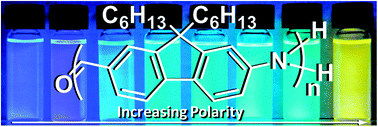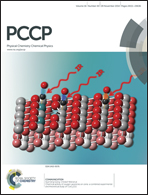Unusually high fluorescence quantum yield of a homopolyfluorenylazomethine – towards a universal fluorophore†
Abstract
The absolute fluorescence quantum yield (Φfl) of a polyfluorenyl azomethine homopolymer was measured as a function of solvent polarity. The solvent induced and temperature dependent fluorescence of the homopolymer were also investigated and they were compared to the corresponding monomer and copolymer. The Φfl of the homopolymer was consistent (45–70%), regardless of solvent polarity with Stokes shifts up to 7460 cm−1 in ethanol. In contrast, the Φfl of its corresponding monomer decreased from 60% in ethanol to 1% in toluene, whereas a Φfl < 5% for its analogous copolymer was measured. Moderate fluorescence yields (Φfl ≈ 25%) were also possible in thin film when co-depositing the homopolymer with PMMA. Cryofluorescence was used to probe the excited state deactivation modes. Deactivation by internal conversion was found to compete with fluorescence. The fluorescence deactivation pathways of the homopolymer and its corresponding monomer could be suppressed at 77 K, resulting in fluorescence turn-on. Both fluorophores were found to detect nitroaromatics.


 Please wait while we load your content...
Please wait while we load your content...